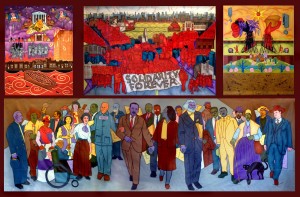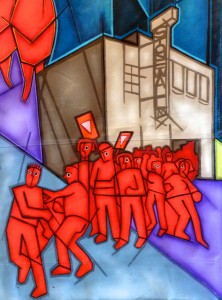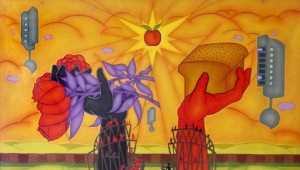History without vision: A struggle over art at the City Museum of New York
05 February 2015 – Briann Greenfield

Mike Alewitz’s “The City at the Crossroads of History” mural was commissioned for the City Museum of New York, which has declined to display it. Photo credit: Mike Alewitz
Muralist and activist Mike Alewitz has finished his tribute to the labor and social justice movements, an imposing four-panel painting titled The City at the Crossroads of History–but the museum it was commissioned for doesn’t want it.
The Puffin Foundation, a grant maker that frequently supports politically left artists, engaged Alewitz to create the mural for a new gallery at the Museum of the City of New York. The gallery is now open with an inaugural exhibit about social activism without the mural, while the artist has launched a petition drive to try to have it displayed as originally planned.
Alewitz and I were colleagues when I taught public history at Central Connecticut State University, and I had the chance to see the in-progress mural many times. It is stunning. One panel invokes the history of greed and labor abuse–slave ships, the Triangle Shirtwaist Factory fire, child labor, and robber barons. Another section includes life-sized portraits of labor leaders and political activists–perfect for a selfie with Martin Luther King, Jr. or Elizabeth Gurley Flynn. There is whimsy, too. In a third panel, workers inhabit Vladimir Tatlin’s Monument to the Third International; an elephant, chicken, pig, and penguin share a pie while space-age cities float overhead. You can explore the full mural here.
Alewitz was always generous with my public history students. Many times he talked to them about his approach to public art, sharing his murals and highlighting the history each commemorated. Invariably, he would quiz the students about the identity of various labor leaders and activists he depicted, and invariably they were stumped. It upset the students to be bested on their history by an artist, but it made the point: the history of social activism, and particularly that of the labor movement, is rarely made visible. For me, that is reason enough why The City at the Crossroads of History must be seen.

The Stonewall Rebellion is one event depicted in the central section of the mural, “The March of the People.” Photo credit: Mike Alewitz
However, the Museum of the City of New York does not agree. In a public statement, director Susan Henshaw Jones asserted the museum’s curatorial authority to decide what to and what not to display. She explained, “As a history museum rather than an art museum, the Museum of the City of New York regularly selects to exhibit works based on their ability to illuminate specific histories. In this case, the museum made the determination that the mural by Mike Alewitz did not meet the curatorial standards or purposes of the museum, and exercised its prerogative and indeed its professional responsibility.”
It is hard to know from Jones’ terse statement exactly why the museum excluded the mural. But when one considers requests the artist received to alter the mural’s content, it appears the museum sought a more politically neutral (one might say “neutered”) depiction of history. According to Alewitz, the Puffin Foundation relayed requests from the museum that he omit the panels depicting the distant past and imagined future, reduce the prominence of Martin Luther and Coretta Scott King, and add “less favorable movements” including New York nativists and the Women’s Christian Temperance Union.
I understand that a history museum would want to portray social activism as politically complex, populated by individuals and movements from across the political spectrum. That is history. But what the museum doesn’t seem to understand is that a piece of art–even a very large mural–is not a history exhibition. A work of art’s function is to embody the artist’s vision and perspective. In cases where the subject matter is drawn from the past, that vision will include historical interpretation, but it isn’t the same kind of nuanced interpretation based on carefully weighted evidence that historians perform. Instead, it represents the artist’s assessment of the past and the lessons he or she draws from it. We seem to know this when we encounter a painting from a distant century. No historian would suggest that Benjamin West painted his Treaty of Penn with the Indians with the intention to simply record the event. Why would we expect something similar of a contemporary artist?

The final triptych panel, titled “Another World is Possible,” references the “Bread and Roses” strike of 1912. Photo credit: Mike Alewitz
Just as we historians value the artwork of the past for its ability to reveal individual perspectives and cultural values, so too should we value the work of contemporary artists for providing a point of view. In Alewitz’s case, his point of view is influenced by years on the front line of peace and social justice movements. What better perspective on the history of social activism could a museum want than someone who was a student leader and eyewitness to the shootings at Kent State, a leader in the national student strike that followed, a union activist, and an internationally known antiwar advocate? For curators, the job is not to suppress such a point of view but to help visitors explore it–a task often assisted by such tools as interpretive labels or the juxtaposition of contrasting opinions.
It has been more than twenty years since artist Fred Wilson created “Mining the Museum,” an exhibit still cited for the powerful way it manipulated the Maryland Historical Society’s collection to evoke injustices experienced by Native Americans and African Americans. As history museums today turn to contemporary art as a means to engage audiences and give history life, I hope they will look to the example set by Wilson and his museum partners rather than replicating the Museum of the City of New York’s over-simple approach. Indeed, Wilson’s work reminds us that contemporary art does have a place in history museums, but it will only be powerful when artists are allowed to express their vision.
~ Briann Greenfield is a public humanist and scholar with many years of experience in public history education and practice.




It’s sad that we still have to refer to Mining the Museum, which took place so long a go. It seems that nobody has had the courage to sponsor something similar since then.
If the mural had been painted by Ben Shahn or Jacob Lawrence, I suspect it would have received a different reception.
Thanks to Briann for a thoughtful response to a complicated situation. I especially appreciate the discussion of how we should consider expectations of contemporary art.
This also raises interesting and difficult issues around power and cultural production. The fact that the holder of the purse strings not only commissions cultural and intellectual products, exercises controls over their content and form and serves as gatekeeper to their display/distribution is not a surprise. The idea that cultural and historical institutions fold under pressure and then point the finger of blame back at the producer without mentioning, let alone implicating, the purse? Yikes.
This seems less about politics and more about a failure of nerve. I’d like to know what the backstory is.
Excellent essay, Briann.